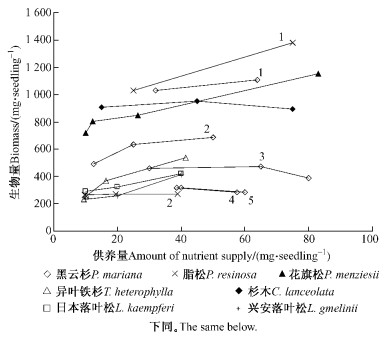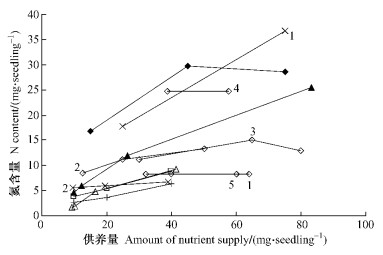文章信息
- 魏红旭, 徐程扬, 马履一, 江俐妮
- Wei Hongxu, Xu Chengyang, Ma Lüyi, Jiang Lini
- 苗木指数施肥技术研究进展
- Advances in Study on Seedling Exponential Fertilization Regime
- 林业科学, 2010, 46(7): 140-146.
- Scientia Silvae Sinicae, 2010, 46(7): 140-146.
-
文章历史
- 收稿日期:2009-03-30
- 修回日期:2009-07-20
-
作者相关文章
由于成本低廉、培育周期短等原因,温室容器育苗目前正逐步成为主要的苗木培育方式。但是容器苗在造林时存在苗体较小和竞争力低等缺点,加之造林地的竞争强烈(Malik et al., 1998)和地力贫瘠(Nilsson et al., 1986; Orlander et al., 1986; Salifu et al., 2001)等问题,传统施肥技术下的容器苗造林效果差的问题始终无法得以解决。尽管林地施肥和植被控制可以改善早期定植苗的造林表现,但改善苗木质量,提高苗木自身竞争力是解决这一问题的有效手段(Malik et al., 1995; 1998)。由此,“养分承载(nutrient loading)”应运而生。
养分承载是指苗木吸收超过正常需求的养分,并将这些养分贮存在体内(Hawkins et al., 2005)以促进苗木移植后的养分再分配(nutrient retranslocation)、根系发育(Timmer, 1996)和生长,提高其竞争力(Malik et al., 1998; Hawkins et al., 2005)。通常实现养分承载的途径有3种(Hawkins et al., 2005):晚季追肥(late-season fertilization),高养全季供肥和指数施肥(Timmer, 1996)。由于指数施肥可以实现包括稳态奢养消耗(steady-state luxury consumption of nutrients)在内的养分积累,避免由于大量养分施入而造成的养分毒害(Timmer, 1996),进而有效提高苗木体内养分含量以增加自身竞争水平, 进而适应造林地的立地条件(Malik et al., 1998; Hawkins et al., 2005),成为当前国外苗木培育中的首选施肥技术,国内相关研究则相对较少。本文总结了国内外关于指数施肥的研究现状,从生物量积累及分配和养分承载及再分配的角度对指数施肥的作用机制进行阐述,并提出目前研究存在的问题和今后几个可能的研究热点和思路,供国内相关研究者参考,推动国内有关指数施肥的研究与应用。
1 指数施肥的概念、原理和方法 1.1 概念和原理指数施肥制度是基于“稳态养分”(steady-status nutrient)理论,通过指数递增的养分添加方式适应植物在各生长阶段的相对生长率的施肥方法(Timmer, 1996)。在这个过程中,维持苗木组织内养分含量的方程式如下:

|
(1) |
其中,n和W分别为养分含量和生物量, t为时间(Ingestad et al., 1986)。Timmer(1996)提出,类似于(1)可以得到:

|
(2) |
即:

|
(3) |
可见,(3)的等号左右分别是苗木相对生长率(RG)和养分吸收率(RU),即:

|
(4) |
只有满足(4),即按照与RG呈显著线性关系的速率来添加养分以满足RU,才能实现养分被植物稳定吸收利用的目的。后经试验证明,通过指数施肥制度培育的苗木,其养分吸收和积累速率完全符合(4)的描述(Timmer et al., 1991)。至此,通过指数施肥来实现植物稳态养分积累的技术得以确立。
1.2 指数施肥方法通常制定指数施肥方案时所采用的计算公式为:

|
(5) |
其中,NT为需要施入的养分总量,NS为施肥初期苗体养分含量(对于容器苗,此值即种子中养分含量),NT+NS即理想状态下施肥后苗木养分含量,T为总施肥次数,r是需要确定的系数。在确定(5)中除系数r外的其他参数值后,可以将(5)转换为:

|
(6) |
根据(6)便可以计算出系数r的值。在计算具体每次施肥量时,采用如下公式:

|
(7) |
其中,t为当前施肥次数,NS含义同(5),r同(6)的求算结果,Nt为当次施肥量,Nt-1为当次前积累施肥量总和。值得注意的是,由于施肥存在着利用效率的问题,一般(5)中的NT和(7)中的Nt值,都高于苗木实际养分吸收水平。
2 指数施肥的国内外研究现状自从20世纪80年代瑞典农业科技大学的Ingestad等(1986; 1987)通过试验研究创立“指数养分承载理论”(exponential nutrient loading theory)以来,指数施肥技术已在多伦多大学的Timmer等(1987; 1991)、Timmer(1996)、Imo等(2001; 2002)、维多利亚大学Hawkins等(2005)、Everett等(2007)和Purdue大学Salifu等(2001; 2003)、Salifu等(2008a; 2008b)的研究带动下,得到广泛推广使用。20世纪90年代是指数施肥研究的热点时期,关于不同树种、不同供养量和供养配比的报道大量涌现(Timmer et al., 1991; Timmer, 1996; Quoreshi et al., 1998)。进入2000年后,更多的报道开始关注指数施肥过程中苗木根系形态的变化及造林效果(Imo et al., 2001; 2002; Salifu et al., 2001; 2003; Hawkins et al., 2005; Everett et al., 2007; Salifu et al., 2008a; 2008b)。指数施肥以其适应幼苗生长和需肥规律,避免养分毒害和促进稳定积累等优点(Timmer, 1996),逐渐成为国外苗木培育的首选施肥技术。
国外用于指数施肥研究的树种主要包括: 1)在仲夏停止生长, 并在夏末秋初时积累养分的树种(Hawkins et al., 2005),如黑云杉(Picea mariana)(Salifu et al., 2001; 2003; Quoreshi et al., 1998; 2000; Boivin et al., 2002; Miller et al., 1997; Malik et al., 1998; Imo et al., 2001; 2002; Salifu et al., 2003),脂松(Pinus resinosa)(Timmer et al., 1987; Miller et al., 1994)和白云杉(Picea glauca)(McAlister et al., 1998)等; 2)以日本落叶松(Larix kaempferi)(Qu et al., 2003)为代表的生长速度快、需养量高的树种; 3)生长期很长的树种,如花旗松(Pseudotsuga menziesii)、西铁杉(Tsuga heterophylla) (Burgess, 1991; Hawkins et al., 2005; Everett et al., 2007)和杉木(Cunninghamia lanceolata) (Xu et al., 1998; 1999)等。这些树种的范围覆盖了加拿大、欧洲的大部分地区以及美国中西部和我国南方亚热带地区,在不同的地理分布范围为指数施肥的研究奠定了坚实的基础。
我国最早接触指数施肥理论开始于1981年我国学者赴瑞典学习稳态养分理论和1982年Ingestad教授应邀访华(郑槐明等,1999)。而真正意义上利用稳态养分理论进行研究的报道是对于兰考泡桐(Paulownia elongata)和刺槐(Robinia pseudoacacia)幼苗的研究(贾慧君等,1989),并且贾慧君等(1993; 1994)和郑槐明等(1999)利用稳态养分理论进行了很多其他方面研究。国内以经典的指数施肥设计的报道首先出现在对侧柏(Platycladus orientalis)(刘洲鸿等,2002)和草坪(李素燕等,2003)的研究中。之后,国内关于指数施肥的研究,尤其关于速生丰产苗木培育的报道很少。
3 指数施肥作用机制 3.1 生物量积累与分配目前关于指数施肥技术对于播种苗生物量积累影响的结果存在着分歧。一些试验结果表明,在苗木培育的第1年通过指数施肥方式可以使苗木在下一年培育初期体内存有大量养分,但是苗木总生物量却不会显著增加(Qu et al., 2003; Salifu et al., 2001; 2003; 2008a; 2008b; Hawkins et al., 2005; Quoreshi et al., 1998; 2000; Boivin et al., 2002); 相反,另一些报道表明,无论温室(Malik et al., 1995; Burgess, 1991)还是大田条件(Malik et al., 1998),指数施肥制度培育下的苗木生物量积累显著增加(Malik et al., 1998)。产生这种分歧的原因可能是不同试验材料的最适需养量不同所致。如图 1所示,在养分添加的过程中,在贫养范围内,养分供给的增加会显著提高生物量、养分含量的水平; 当养分供给达到充足量时,生物量积累不会随着养分的继续添加而显著增加,但是养分含量会继续随着供养量的增加而提高; 一旦供养量超过苗木的最适需养量,苗木的生物量积累不再继续增加,甚至会产生下降(Timmer, 1996),单株养分含量因受毒害影响而有所下降,而养分质量分数会随着养分的供给而始终保持增加。如图 2所示,在以黑云杉为试验材料的报道中,当供养量<25 mg·株-1的范围内,黑云杉苗木的生物量积累随着供养量的提高而上升,表明此供养量为黑云杉的充足量(图 1); 当供养量在25~65 mg·株-1范围内时,各报道结果均显示黑云杉生物量无显著增加(Malik et al., 1998; Quoreshi et al., 1998; 2000; Salifu et al., 2001; 2003; Boivin et al., 2002; Miller et al., 1997),而当供养量大于65 mg·株-1后便会引起养分毒害,这表明65 mg·株-1为黑云杉的最适供养量(以N量计)。类似的,从图 2中还可以看出,40~43 mg·株-1的供养量只是日本落叶松(Qu et al., 2003)、兴安落叶松(Qu et al., 2003)和脂松(Miller et al., 1994)的充足供养范围,但是却已经达到杉木(Xu et al., 1998; 1999)的最适供养量。可见,在对苗木进行施肥前,掌握苗木的需肥规律、了解苗木的充足和最适需养量对于指数施肥的研究具有十分重要的意义。

|
图 1 养分供给与苗木生长和养分状况间关系(Salifu et al., 2003) Figure 1 Relationship between nutrient supply with plant growth and nutrient status (Salifu et al., 2003) |

|
图 2 苗木指数施肥试验中供养量与生物量间关系(以N量计) Figure 2 Summary of relationship between amount of nutrient supply and biomass under exponential fertilizer regimes 数据来源Data resources:◇1 Malik et al., 1998; ◇2 Quoreshi et al., 1998; 2000; ◇3 Salifu et al., 2001; 2003; ◇4 Boivin et al., 2002; ◇5 Miller et al., 1997; ×1 Miller et al., 1994; ×2 Timmer et al., 1987; ▲ Burgess, 1991a; △ Burgess, 1991b; ◆ Xu et al., 1998; 1999; □ Qu et al., 2003a; + Qu et al., 2003b.下同。The same below. (caculated by amount of N supply) |
除了供养量外,试验方法的不同也会引起指数施肥结果的不同。对比前人利用不同植物材料进行的指数施肥试验可发现,在以黑云杉为试验材料的指数施肥研究中(图 2),虽然容器容积和养分配比同为40 cm3和20-20-20,Malik等(1998)所采用的18周培育期引起苗木在30~70 mg·株-1的供养量范围内的生物量积累高达1 030~1 110 mg·株-1,而Quoreshi等(1998; 2000)、Salifu等(2001; 2003)、Boivin等(2002)采用不同培育周期的结果却显示在这个供养量范围内生物量只有280~690 mg·株-1。Timmer等(1987)在以脂松为试验材料的报道(图 2)中所采用的供养比例为100-13-65,而在相同试验材料、容器大小和处理时间的情况下,Miller等(1994)将供养比例改为20-20-20后,得到的生物量积累远大于Timmer等(1987)的报道。另外,在相同的供养总量范围内,试验材料的不同也是造成苗木生物量积累差异的原因之一。
不仅苗圃培育阶段,在造林时人们同样认为经过指数施肥制度培育的苗木生物量积累更具优势(Timmer et al., 1991; Salifu et al., 2001)。Timmer等(1991)的研究结果表明,第1年经过指数施肥培育的苗木在移植后具有比传统施肥更高的生长量,特别是在养分贫瘠的立地条件下。Salifu等(2001)通过培育第2年移植后的120天动态观察研究发现,第1年指数施肥的苗木生物量积累速率普遍高于传统施肥制度。Timmer等(2004)将这种现象解释为由于指数施肥使得苗木积累大量养分,不仅促进移植后根系的发育,也间接促进根系的养分吸收,因此苗木得以更快地发生新芽而提前生长。
一些报道指出指数施肥的苗木往往将更多的生物量分配到地下部分,即具有更高的根茎比例(Timmer et al., 1991)。但也有报道表明,经指数施肥处理的苗木根茎比与传统施肥处理差不多(Hawkins et al., 2005),甚至较小(Timmer et al., 1987; 1991; Xu et al., 1997)。虽然目前关于指数施肥对于根茎比的影响尚无明确的合理解释,但是可以推测导致根茎比不同的原因是苗木对于养分供给的响应,即当供养量没有达到苗木最适需肥量或苗木处于养分承载阶段时,生物量会向根系分配以吸收养分; 而如果供养量超过苗木的最适养分需要量,生物量向根系的分配比例就会减少。该推测是否合理还有待进一步研究论证。
3.2 养分吸收与分配 3.2.1 养分吸收大量报道表明,指数施肥的养分(尤其是N)承载水平要显著高于传统施肥(Qu et al., 2001; Salifu et al., 2003; Miller et al., 1997; Quoreshi et al., 1998; Xu et al., 1998)。Qu等(2003)的研究结果表明,指数施肥处理下整株苗木的N含量显著高于传统处理,并且苗木在指数施肥制度下吸收的N随着供养水平的增加而显著增加。Xu等(1997)通过对杉木的研究发现,经过发芽后22周的培育,指数施肥制度下的苗木比传统施肥制度下的苗木的N,P含量分别高72.2%和51.5%。Salifu等(2003)在对养分再分配的观察之前通过试验发现,指数施肥制度下苗木的N装载量为22 mg·株-1,而传统施肥只有8 mg·株-1。Timmer(1996)认为这种现象产生的原因有2点: 1)由于早期苗体较小,根系发育尚不健全,因此在苗木生长前期中往往存在着一段养分“滞后期”(lag phase)(Ingestad et al., 1986),传统的施肥方式在早期对苗木添加相对过多的养分; 由于在苗木生长后期生物量积累的速率高于养分吸收速率,因此苗木自身存在着养分稀释(nutrient dilution)现象,传统施肥方式对生长后期的苗木来说供养量相对不足; 2)苗木在生长中后期普遍存在“奢养消耗”(luxury nutrient consumption)现象,在传统的施肥方式下,当施肥量超过苗木正常需养量不但不会使得生物量继续积累,而且有可能产生养分毒害作用,但是稳态增加的养分不仅避免大量养分对于苗木的毒害,同时会诱导苗木吸收超出本身需求量以外的养分(Qu et al., 2003)。
与指数施肥技术对生物量的影响类似,不同供养量同样会导致苗木养分吸收的差异。以N为例,如图 3所示,以黑云杉为试验材料的报道中,当供养量超过65 mg·株-1后,苗木N含量显著下降(Salifu et al., 2001; 2003),这说明65 mg·株-1的供养量对黑云杉来说属于最适量,此结果与指数施肥对其生物量的影响结果一致(图 2)。同时,从图 3还可以看出,在供养量小于40 mg·株-1时大部分苗木的N吸收都随着养分添加量的增加而提高,当供养量达到45 mg·株-1后,杉木(Xu et al., 1998; 1999)的N含量开始下降,可见45 mg·株-1的供养量达到杉木的最适养分添加量。

|
图 3 苗木指数施肥试验中供养量与生物量间关系(以N量计) Figure 3 Summary of relationship between amount of nutrient supply and N content under exponential fertilizer regimes (caculated by amount of N supply) |
试验方法也会影响苗木对于养分的吸收水平。Boivin等(2002)以黑云杉为试验材料的报道显示(图 3),40 cm3的容器、20-20-20的供养配比和培育15周的方法可以使得苗木在40~60 mg·株-1的供养量范围内获得高达24.71 mg·株-1的N含量,而将处理时间延长至18周(Malik et al., 1998)或者减少至14周(Miller et al., 1997)都会降低苗木的N含量。同样,在对脂松的培育中,Miller等(1994)将营养液中N-P-K比例由从前的100-13-65(Timmer et al., 1987)调整为20-20-20后,苗木在25~40 mg·株-1供养范围内的N吸收速率得到很大提升(图 3)。可见,针对不同树种,选择合理的养分培育周期和配方对苗木的养分吸收起着非常重要的作用。
3.2.2 养分的再分配相对于苗木培育过程中养分在苗木体内的分配来说,目前人们更关注指数施肥对于移植后苗木的养分再分配(nutrient retranslocation)的影响(Qu et al., 2003; Malik et al., 1998; Xu et al., 1999; Salifu et al., 2001)。养分再分配是指植物体内原有器官衰老时养分为植物的新生部分所用的现象(Lim et al., 1986),是改善移植苗生长、养分利用(Kim et al., 1987; Lim et al., 1986)和提高竞争能力的关键机制(Malik et al., 1998)。由于早春土壤温度较低(Atkin, 1996),根系的生长(Burdett, 1990)和养分吸收(Salifu et al., 2003)能力受到限制,苗木必须依靠上年吸收存储的养分来满足新生部分的养分需要(Chapin, 1990; Miller et al., 1979; Fagerstrom et al., 1977); 指数施肥能够有效提高苗木的养分存储水平,培育的苗木更适应新生器官的养分需要(Malik et al., 1998; Xu et al., 1999)。Salifu等(2001)的研究结果表明,在移植后60天里,指数施肥制度下N的再分配率为50%,符合第2年新生地上部分的46%的N需求,而传统施肥技术下的新生地上部分的N需求和再分配率只有18%,同时指数施肥制度下的P和K的净再分配率分别比传统施肥高185%和102%。Salifu等(2001)报道的关于N的再分配结果略高于Xu等(1999)、Munson等(1995)、Nambiar等(1987)的结果,这可能与Salifu等(2001)所采用的试验材料与前人不同有关。
目前有关养分再分配与土壤养分间的关系存在着分歧。Salifu等(2001)发现,无论在贫养(poor site)(Miller et al., 1976)或富养立地(rich site)(Proe et al., 1994; Munson et al., 1995)条件下,指数施肥都会促进苗木的养分再分配。对此Salifu等(2001)推测养分再分配与土壤养分间无相关关系。相反,也有观点认为土壤贫瘠与苗木养分再分配间具有一定联系(Burdett, 1990)。也许通过指数施肥的方法使得苗木体内储存足够多的养分后,移植时的立地养分贫瘠情况对于养分再分配的影响相对显得微不足道; 而如果没有采用指数施肥制度或者供养总量不够大的话,立地条件对于养分再分配的影响便会突显出来。
4 研究存在的问题和展望目前世界上关于指数施肥的研究非常广泛,涵盖了10多种常见造林树种的苗木培育、冬藏、移植到造林的一系列过程,但其测定的数据大多停留在养分分析和生物量测定水平上,对其机制的探讨比较少,尤其对于养分和光合产物的“汇”与“源”关系的探讨十分匮乏,对于苗木在指数养分承载过程中的各种次生代谢物质的变化尚不清晰。另外, 目前大多数指数施肥处理是针对温室容器苗开展,在大田条件下利用裸根苗的试验相对较少。虽然近年来国外已经陆续开展一些大田条件下的指数施肥试验(Birge et al., 2006),但是目前国外的研究重点是利用指数施肥的养分承载特性观察苗木的造林效果,对于大田条件下的养分承载和苗木生物量积累动态的观察目前还比较匮乏,尤其在大田条件下如何应用指数施肥的理念实现精准、经济和高效的施肥有待进一步研究。
目前国外对于指数施肥的研究在广度和深度上都已经达到一定水平,在温室容器育苗的条件下经过1个生长期的培育,苗木便达到出圃标准,且定植后具有良好的表现。我国目前在苗木的养分供给制度方面的研究还相当的匮乏,没有形成科学的养分供给方法,施肥效率十分低下。与国外相比,我国目前选用的速生丰产苗木种类十分丰富,其中诸如红松(Pinus koraiensis)、云杉、落叶松和马尾松(Pinus massoniana)等都能发挥极大的经济和生态效应,但是目前国内对于这些苗木种类培育的瓶颈是无法缩短其培育周期,不仅成本比较高,而且对环境的污染也比较严重。如果将指数施肥方法引入我国的苗木培育体系中,不仅可以缩短苗木的培育周期,提高苗木质量和造林效果,同时,还可以降低成本、减少环境污染。但是这中间还有很长路要走,比如打破我国现有的依赖于形态指标的苗木质量评价方法、在大田环境下采用指数施肥的理论进行培育、对于苗木的追肥时间和次数的精准控制和开发适应指数施肥技术的新的苗木种类等。
贾慧君, IngestadT. 1989. 兰考泡桐和刺槐幼苗最适营养需要的研究[J]. 林业科学, 25(1): 1-7. |
贾慧君, 郑槐明. 1993. 兰考泡桐幼苗稳态矿质营养比较研究[J]. 北京林业大学学报, 15(3): 12-19. |
贾慧君, 郑槐明, 李江南, 等. 1994. 稳态营养原则在杉木、湿地松苗木施肥中的应用[J]. 北京林业大学学报, 16(4): 65-75. |
李素艳, 孙向阳, 刘凯英. 2003. 指数施肥技术在草坪培育中的应用[J]. 北京林业大学学报, 25(4): 44-48. |
刘洲鸿, 刘勇, 段树生. 2002. 不同水分条件下施肥对侧柏苗木生长及抗性的影响[J]. 北京林业大学学报, 24(5/6): 56-61. |
郑槐明, 贾慧君. 1999. 植物稳态矿质营养理论与技术研究及展望[J]. 林业科学, 35(1): 94-104. |
Atkin O K. 1996. Reassessing the nitrogen relationships of artic plants: A mini-review[J]. Plant, Cell & Environment, 19: 695-704. |
Burgess D. 1991. Western hemlock and Douglas-fir seedling development with exponential rates of nutrient addition[J]. Forestry Science, 37: 54-67. |
Burdett A N. 1990. Physiological process in plantation establishment and development of specifications for forest planting stock[J]. Canada Journal of Forestry Research, 20: 415-427. DOI:10.1139/x90-059 |
Boivin J R, Miller B D, Timmer V R. 2002. Late-season fertilization of Picea mariana seedlings under greenhouse culture: biomass and nutrient dynamics[J]. Annals of Forest Science, 59: 255-264. DOI:10.1051/forest:2002021 |
Everett K T, Hawkins B J, Kiiskila S. 2007. Growth and nutrient dynamics of Douglas-fir seedlings raised with exponential or conventional fertilization and planted with or without fertilizer[J]. Canada Journal of Forestry Research, 37: 2552-2562. DOI:10.1139/X07-108 |
Fagerstrom T, Lohm U. 1977. Growth in Scot pine(Pinus sylvestris): mechanisms of response to nitrogen[J]. Oecologia, 26: 305-315. DOI:10.1007/BF00345530 |
Hawkins B J, Burgess D, Mitchell A K. 2005. Growth and nutrient dynamics of western hemlock with conventional or exponential greenhouse fertilization and planting in different fertility conditions[J]. Canada Journal of Forestry Research, 35: 1002-1016. DOI:10.1139/x05-026 |
Imo M, Timmer V R. 1992. Nitrogen uptake of mesquite seedlings at conventional and exponential fertilization schedules[J]. Soil Science Society of America, 56: 927-934. DOI:10.2136/sssaj1992.03615995005600030041x |
Imo M, Timmer V R. 2001. Growth and nitrogen retranslocation of nutrient loaded Picea mariana seedlings planted on boreal mixedwood sites[J]. Canada Journal of Forestry Research, 31: 1357-1366. DOI:10.1139/x01-063 |
Imo M, Timmer V R. 2002. Growth and nutritional interactions of nutrient-loaded black spruce seedlings with neighboring natural vegetation under greenhouse conditions[J]. Forestry Science, 48: 77-84. |
Ingestad T, Lund A B. 1986. Theory and techniques for steady state mineral nutrition and growth of plants[J]. Scand Journal of Forestry Research, 1: 439-453. DOI:10.1080/02827588609382436 |
Ingestad T. 1987. New concepts in soil fertility and plant nutrition as illustrated by research on forest trees and stands[J]. Geoderma, 40: 237-252. DOI:10.1016/0016-7061(87)90035-8 |
Kim Y T, Glerum C, Stoddart J, et al. 1987. Effect of fertilization on free amino acid concentration in black spruce and jack pine containerized seedlings[J]. Canada Journal of Forestry Research, 17: 27-30. DOI:10.1139/x87-005 |
Lim M T, Cousens J E. 1986. The internal transfer of nutrients in Scot pine stand.Ⅰ. Biomass components, current growth and their nutrient contents[J]. Forestry, 59: 1-6. DOI:10.1093/forestry/59.1.1 |
Miller H G, Cooper J M, Milller J D. 1976. Effect of nitrogen supply on nutrient in litter fall and crown leaching in a stand of Corsican pine[J]. Journal of Appled Ecology, 13: 233-256. DOI:10.2307/2401943 |
Miller H G, Cooper J M, Miller J D, et al. 1979. Nutrient cycles in pines and their adaptation to poor soils[J]. Canada Journal of Forestry Research, 9: 19-26. DOI:10.1139/x79-004 |
Miller B D, Timmer V R. 1994. Steady-state nutrition of Pinus resinosa seedlings response to nutrient loading, irrigation and hardening regimes[J]. Tree Physiology, 14: 1327-1338. DOI:10.1093/treephys/14.12.1327 |
Miller B D, Timmer V R. 1997. Nutrient dynamics and carbon partitioning in nutrient loaded Picea mariana (Mill) B.S.P. seedlings during hardening[J]. Scand Journal of Forestry Research, 12: 122-129. DOI:10.1080/02827589709355393 |
Milard P, Proe M F. 1992. Storage and internal cycling of nitrogen in relation to seasonal growth of Sitka spruce[J]. Tree Physiology, 10: 33-43. DOI:10.1093/treephys/10.1.33 |
Malik V, Timmer V R. 1995. Interaction of nutrient-loaded black spruce seedlings with neighbouring vegetation in greenhouse environments[J]. Canada Journal of Forestry Research, 25: 1017-1023. DOI:10.1139/x95-110 |
Malik V, Timmer V R. 1998. Biomass partitioning and nitrogen retraslocation in black spruce seedlings on competitive mixed wood sites: a bioassay study[J]. Canada Journal of Forestry Research, 28: 206-215. DOI:10.1139/x97-207 |
McAlister J A, Timmer V R. 1998. Nutrient enrichment of white spruce seedlings during nursery culture and initial plantation establishment[J]. Tree Physiology, 18: 195-202. DOI:10.1093/treephys/18.3.195 |
Munson A D and Bernier P Y. 1993. Comparing natural and planted black spruce seedlings.Ⅱ. Nutrient uptake and efficiency of use[J]. Canada Journal of Forestry Research, 23: 2435-2442. DOI:10.1139/x93-301 |
Munson A D, Margolis H A, Brand D G. 1995. Seasonal nutrient dynamics in white pine and white spruce in response to environmental manipulation[J]. Tree Physiology, 15: 141-149. DOI:10.1093/treephys/15.3.141 |
Nilsson U, Gemmel P, Hallgren J E. 1986. Competing vegetation effects on initial growth of planted Picea abies[J]. New Zealand Journal of Forestry Science, 26: 84-98. |
Nelson L E, Shelton M G, Switzer G L. 1995. The influence of nitrogen application on resorption of foliar nutrients in sweetgum[J]. Canada Journal of Forestry Research, 25: 298-306. DOI:10.1139/x95-034 |
Orlander G, Nilsson U, Hallgren J E. 1986. Competition for water and nutrients between grown vegetation and planted Picea abies[J]. New Zealand Journal of Forestry Science, 269: 99-117. |
Pettersson S. 1986. Growth, contents of K+ and kinetics of K+ (86Rb) uptake in barley cultured at different supply rates of potassium[J]. Physiology of Plant, 66: 122-128. DOI:10.1111/ppl.1986.66.issue-1 |
Proe M F, Millard P. Relationship between nutrient supply, nitrogen partitioning, and growth in young Sitka spruce (Picea sitchensis)[J]. Tree Physiology, 14: 75-88. DOI:10.1093/treephys/14.1.75 |
Qu L, Quoreshi A M, Koike T. 2003. Root growth characteristics, biomass and nutrient dynamics of seedlings of two larch species raised under different fertilization regimes[J]. Plant and Soil, 255: 293-302. DOI:10.1023/A:1026159709246 |
Quoreshi A M, Timmer V R. 1998. Exponential fertilization increases nutrient uptake and ectomycorrhizal development of black spruce seedlings[J]. Canada Journal of Forestry Research, 28: 674-682. DOI:10.1139/x98-024 |
Quoreshi A M, Timmer V R. 2000. Early outplanting performance of nutrient-loaded containerized black spruce seedlings inoculated with Laccaria bicolor: a bioassay study[J]. Canada Journal of Forestry Research, 30: 744-752. DOI:10.1139/x00-003 |
Salifu K F, Timmer V R. 2001. Nutrient retranslocation response of Picea mariana seedlings to nitrogen supply[J]. Soil Science Society of America Journal, 65: 905-913. DOI:10.2136/sssaj2001.653905x |
Salifu K F, Timmer V R. 2003. Nitrogen retraslocation response of young Picea mariana to nitrogen-15 supply[J]. Soil Science Society of America Journal, 67: 309-318. |
Salifu K F, Jacobs D F, Birge Z K D. 2008a. Performance of nutrient-loaded red oak and white oak seedlings on mine lands in southern Indiana[J]. Rocky Mountain Research Station, 57: 65-71. |
Salifu K F, Jacobs D F, Birge Z K D. 2008b. Nursery nitrogen loading improves field performance of bareroot oak seedlings planted on abandoned mine lands[J]. Restoration Ecology, 11: 1-12. |
Timmer V R, Teng Y. 2004. Pretransplant fertilizatoin of containerized Picea mariana seedlings: calibration and bioassay growth response[J]. Canada Journal of Forestry Research, 34: 2089-2099. DOI:10.1139/x04-088 |
Timmer V R. 1996. Exponential nutrient loading: a new fertiilzation technique to improve seedling performance on competitive sites[J]. New Forest, 13: 275-295. |
Timmer V R, Armstrong G. 1987. Growth and nutrition of Pinus resinosa at exponentially increasing nutrient additions[J]. Canada Journal of Forestry Research, 17: 644-647. DOI:10.1139/x87-105 |
Timmer V R, Miller B D. 1991. Effects of contrasting fertilization and irrigation regimes on biomass, nutrients and water relations of container grown red pine seedlings[J]. New Forest, 5: 335-348. DOI:10.1007/BF00118861 |
Timmer V R, Munson A D. 1991. Site-specific growth and nutrition of planted Picea mariana in the Ontario clay belt.Ⅳ. Nitrogen-loading response[J]. Canada Journal of Forestry Research, 21: 1058-1065. DOI:10.1139/x91-145 |
Xu X J, Timmer V R. 1998. Biomass and nutrient dynamics of Chinese fir seedlings under conventional and exponential fertilization regimes[J]. Plant and Soil, 203: 313-322. DOI:10.1023/A:1004307325328 |
Xu X J, Timmer V R. 1999. Growth and nitrogen nutrition of Chinese fir seedlings exposed to nutrient loading and fertilization[J]. Plant and Soil, 216: 83-91. DOI:10.1023/A:1004733714217 |
 2010, Vol. 46
2010, Vol. 46

